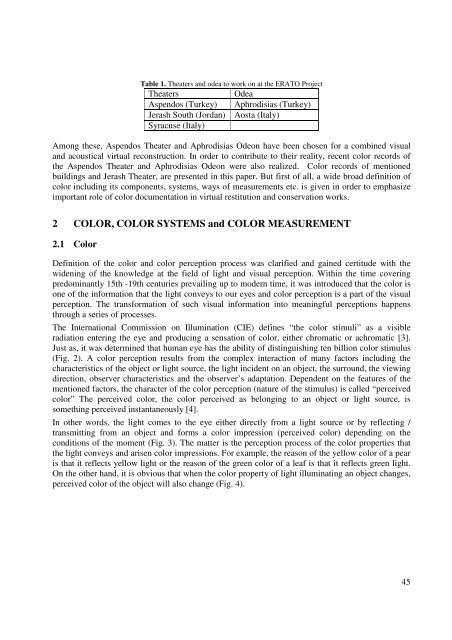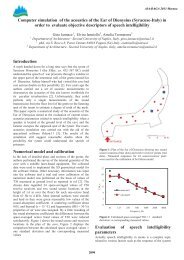ERATO Proceedings Istanbul 2006.pdf - Odeon
ERATO Proceedings Istanbul 2006.pdf - Odeon
ERATO Proceedings Istanbul 2006.pdf - Odeon
Create successful ePaper yourself
Turn your PDF publications into a flip-book with our unique Google optimized e-Paper software.
Table 1. Theaters and odea to work on at the <strong>ERATO</strong> Project<br />
Theaters<br />
Odea<br />
Aspendos (Turkey) Aphrodisias (Turkey)<br />
Jerash South (Jordan) Aosta (Italy)<br />
Syracuse (Italy)<br />
Among these, Aspendos Theater and Aphrodisias <strong>Odeon</strong> have been chosen for a combined visual<br />
and acoustical virtual reconstruction. In order to contribute to their reality, recent color records of<br />
the Aspendos Theater and Aphrodisias <strong>Odeon</strong> were also realized. Color records of mentioned<br />
buildings and Jerash Theater, are presented in this paper. But first of all, a wide broad definition of<br />
color including its components, systems, ways of measurements etc. is given in order to emphasize<br />
important role of color documentation in virtual restitution and conservation works.<br />
2 COLOR, COLOR SYSTEMS and COLOR MEASUREMENT<br />
2.1 Color<br />
Definition of the color and color perception process was clarified and gained certitude with the<br />
widening of the knowledge at the field of light and visual perception. Within the time covering<br />
predominantly 15th -19th centuries prevailing up to modern time, it was introduced that the color is<br />
one of the information that the light conveys to our eyes and color perception is a part of the visual<br />
perception. The transformation of such visual information into meaningful perceptions happens<br />
through a series of processes.<br />
The International Commission on Illumination (CIE) defines “the color stimuli” as a visible<br />
radiation entering the eye and producing a sensation of color, either chromatic or achromatic [3].<br />
Just as, it was determined that human eye has the ability of distinguishing ten billion color stimulus<br />
(Fig. 2). A color perception results from the complex interaction of many factors including the<br />
characteristics of the object or light source, the light incident on an object, the surround, the viewing<br />
direction, observer characteristics and the observer’s adaptation. Dependent on the features of the<br />
mentioned factors, the character of the color perception (nature of the stimulus) is called “perceived<br />
color” The perceived color, the color perceived as belonging to an object or light source, is<br />
something perceived instantaneously [4].<br />
In other words, the light comes to the eye either directly from a light source or by reflecting /<br />
transmitting from an object and forms a color impression (perceived color) depending on the<br />
conditions of the moment (Fig. 3). The matter is the perception process of the color properties that<br />
the light conveys and arisen color impressions. For example, the reason of the yellow color of a pear<br />
is that it reflects yellow light or the reason of the green color of a leaf is that it reflects green light.<br />
On the other hand, it is obvious that when the color property of light illuminating an object changes,<br />
perceived color of the object will also change (Fig. 4).<br />
45
















